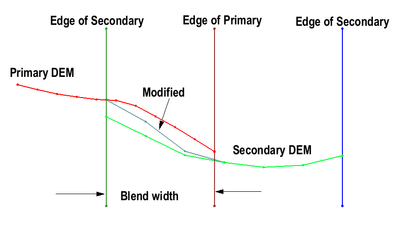Template:Blend Raster to Edges: Difference between revisions
From XMS Wiki
Jump to navigationJump to search
(Created page with "__NOINDEX__ ===Blend Raster to Edges=== This tool blends the secondary raster into the edges of the primary raster. The tool has the following options: *''Primary raster'' &nd...") |
No edit summary |
||
| (10 intermediate revisions by 4 users not shown) | |||
| Line 1: | Line 1: | ||
__NOINDEX__ | __NOINDEX__ | ||
__NOTOC__ | |||
===Blend Raster to Edges=== | ===Blend Raster to Edges=== | ||
<!--====Tool description====--> | |||
*''Primary raster'' – Use the drop-down to select the raster that will be | The ''Blend Raster to Edges'' tool is intended to facilitate the use of multiple topo/bathy DEMs (potentially from multiple sources) as a source for elevation data on a surface and avoid discontinuities that may exist between the DEMs. | ||
*''Secondary raster'' – Use the drop-down to | |||
The tool creates a new raster that is a modified version of the raster that is the second argument to the tool. The modified version transition along its active edges from the values in the raster to the values in the ''primary'' raster (the first argument). | |||
This tool is intended to be used to pre-condition topo/bathy sources for use in the [[Template:Interpolate Priority Rasters|Interpolate Priority Rasters]] tool. | |||
[[File:Blend Raster to Edges.png|thumb|none|400 px|Blend raster to edges]] | |||
====Input parameters==== | |||
*''Primary raster'' – Use the drop-down to select the raster that will be designated as the primary raster. | |||
*''Secondary raster'' – Use the drop-down to select the raster that will be designated as the secondary raster. | |||
*''Blend width along edge'' – Where the edges of the primary and secondary rasters meet, the edges will be blended to the width specified with this option. | *''Blend width along edge'' – Where the edges of the primary and secondary rasters meet, the edges will be blended to the width specified with this option. | ||
====Output parameters==== | |||
*''Output raster'' – Provide a name for the new blended raster. | *''Output raster'' – Provide a name for the new blended raster. | ||
====Current Location in toolbox==== | |||
Rasters/Blend Raster to Edges | |||
====Related Tools==== | |||
* [[Template:Interpolate Priority Rasters|Interpolate Priority Rasters]] | |||
* [[Template:Clip Raster from Elevation|Clip Raster from Elevations]] | |||
{{-}} | {{-}} | ||
<noinclude>[[Category: | <noinclude>[[Category:Toolbox Rasters]]</noinclude> | ||
Latest revision as of 17:27, 26 October 2023
Blend Raster to Edges
The Blend Raster to Edges tool is intended to facilitate the use of multiple topo/bathy DEMs (potentially from multiple sources) as a source for elevation data on a surface and avoid discontinuities that may exist between the DEMs.
The tool creates a new raster that is a modified version of the raster that is the second argument to the tool. The modified version transition along its active edges from the values in the raster to the values in the primary raster (the first argument).
This tool is intended to be used to pre-condition topo/bathy sources for use in the Interpolate Priority Rasters tool.
Input parameters
- Primary raster – Use the drop-down to select the raster that will be designated as the primary raster.
- Secondary raster – Use the drop-down to select the raster that will be designated as the secondary raster.
- Blend width along edge – Where the edges of the primary and secondary rasters meet, the edges will be blended to the width specified with this option.
Output parameters
- Output raster – Provide a name for the new blended raster.
Current Location in toolbox
Rasters/Blend Raster to Edges
Related Tools
